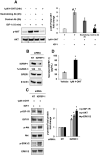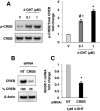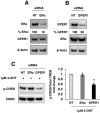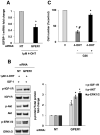GPER1-mediated IGFBP-1 induction modulates IGF-1-dependent signaling in tamoxifen-treated breast cancer cells
- PMID: 26690777
- PMCID: PMC4742395
- DOI: 10.1016/j.mce.2015.11.033
GPER1-mediated IGFBP-1 induction modulates IGF-1-dependent signaling in tamoxifen-treated breast cancer cells
Abstract
Tamoxifen, a selective estrogen receptor modulator, is a commonly prescribed adjuvant therapy for estrogen receptor-α (ERα)-positive breast cancer patients. To determine if extracellular factors contribute to the modulation of IGF-1 signaling after tamoxifen treatment, MCF-7 cells were treated with IGF-1 in conditioned medium (CM) obtained from 4-OHT-treated MCF-7 cells and the accumulation of phospho-Akt (S473) was measured. CM inhibited IGF-1-dependent cell signaling and suggesting the involvement of extracellular factors (ie. IGFBPs). A significant increase in IGFBP-1 mRNA and extracellular IGFBP-1 protein was observed in 4-OHT-treated MCF-7 cells. Knockdown experiments demonstrated that both GPER1 and CREB mediate IGFBP-1 induction. Furthermore, experiments showed that 4-OHT-dependent IGFBP-1 transcription is downstream of GPER1-activation in breast cancer cells. Additionally, neutralization and knockdown experiments demonstrated a role for IGFBP-1 in the observed inhibition of IGF-1 signaling. These results suggested that 4-OHT inhibits IGF-1 signaling via GPER1 and CREB mediated extracellular IGFBP-1 accumulation in breast cancer cells.
Keywords: Breast cancer; GPER1; IGF-1; IGFBP-1; Tamoxifen.
Copyright © 2015 The Authors. Published by Elsevier Ireland Ltd.. All rights reserved.
Figures







References
-
- Ariazi EA, Brailoiu E, Yerrum S, Shupp HA, Slifker MJ, Cunliffe HE, Black MA, Donato AL, Arterburn JB, Oprea TI, Prossnitz ER, Dun NJ, Jordan VC. The G Protein-Coupled Receptor GPR30 Inhibits Proliferation of Estrogen Receptor-Positive Breast Cancer Cells. Cancer Res. 2010;70:1184–1194. - PMC - PubMed
-
- Arteaga CL. Interference of the IGF system as a strategy to inhibit breast-cancer growth. Breast Cancer Res. Treat. 1992;22:101–106. - PubMed
Publication types
MeSH terms
Substances
Grants and funding
LinkOut - more resources
Full Text Sources
Other Literature Sources
Medical
Miscellaneous

